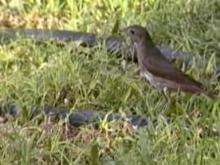Luscinia
| Luscinia | |
|---|---|
 | |
| Adult male bluethroat (Luscinia svecica) | |
| Scientific classification | |
| Kingdom: | Animalia |
| Phylum: | Chordata |
| Class: | Aves |
| Order: | Passeriformes |
| Family: | Muscicapidae |
| Subfamily: | Saxicolinae |
| Genus: | Luscinia T. Forster, 1817 |
| Species | |
|
Several, see text | |
| Synonyms | |
|
Calliope Gould, 1836 | |
Luscinia is a genus of smallish passerine birds, containing the nightingales and relatives. Formerly classed as members of the thrush family Turdidae, they are now considered to be Old World flycatchers (Muscicapidae) of the chat subfamily (Saxicolinae). The chats are a lineage of Old World flycatchers that has evolved convergently to thrushes.
Description

The Luscinia species are stocky small birds, 13–16 cm long with an upright stance and a moderately short frequently cocked tail. They watch for insects, worms and other invertebrates from a low perch, and feed mostly on the ground, hopping, with frequent stops, on their strong legs. They are territorial during the breeding season, and most occur as far north as to be migratory.[1]
In the three species named as nightingales, the sexes are similar. They are plain brown above, whitish below with light streaking, and have a rufous tail. In the other Luscinia species, the male is much brighter than the cryptic, usually brownish-grey female. Males have a dark blue, black or brown back, and red, orange or blue on the throat and upper breast. Several have white or rufous patches on the sides of the tail, giving a pattern recalling that of the closely related wheatear (Oenanthe), or some of the less closely related Muscicapinae (e.g. red-breasted flycatcher, Ficedula parva). The songs of this genus are often complex and musical, especially in the "typical" nightingales.[1]
They are birds of Eurasia, occurring from the subarctic to the tropical regions. They are plentiful in temperate regions, and many of the birds in this genus are strongly migratory, wintering in tropical Africa, India or Southeast Asia.[1]
The breeding habitat is typically scrub or forest, and their cup nest is usually constructed low in a bush. The birds can be difficult to see in dense undergrowth, especially if not singing, but they may frequent somewhat more open habitats in their winter quarters.[1]
Taxonomy and systematics
Luscinia was used for nightingales and similar birds in Classical Latin already (e.g. in the AD 70s Naturalis Historia by Pliny the Elder), if not earlier. Etymologically, it might be derived from luscus (Latin for "half-blind", "half-understood" etc.) or clueō (Latin for "to be well-known") + (probably) Latin canō "to sing". Hence, it could be translated as "little-seen [as in the twilight] songster" or "famous songster".[2]
The species currently placed in Luscinia are:
- Bluethroat, Luscinia svecica
- Siberian rubythroat, Luscinia calliope
- Rufous-tailed robin or Swinhoe's nightingale, Luscinia sibilans
- Thrush nightingale, Luscinia luscinia
- Common nightingale or rufous nightingale, Luscinia megarhynchos
- Indian blue robin or Indian bluechat, Luscinia brunnea
- White-tailed rubythroat, Luscinia pectoralis
- Rufous-headed robin, Luscinia ruficeps
- Blackthroat, Luscinia obscura
- Firethroat, Luscinia pectardens
- Siberian blue robin, Luscinia cyane
Delimitation of Luscinia versus the genus Erithacus has been confused for long; species were rather indiscriminately placed in one or the other genus, or Luscinia was entirely merged into Erithacus. Recent research suggests that the genera should be rearranged, with the East Asian species (like the Siberian blue robin and the Japanese robin, E. akahige) forming a distinct genus or belonging into Luscinia. No matter how they are eventually divided up, Erithacus and Luscinia are distinct and ancient lineages of the chats.[3]
Fossil record
Fossil remains of a probable Luscinia resembling to the larger members of the genus have been found at Polgárdi in Hungary. They date from the Messinian age, around 12 to 7.3 million years ago (Ma) during the Late Miocene subepoch. A Late Pliocene fossil from Rębielice Królewskie (Poland), of Piacenzian age (around 3 Ma), could be an ancestral bluethroat. A supposed Sylvia warbler fossil from the late Gelasian of Bad Deutsch-Altenburg (Austria), about 2 Ma old, may be of a Luscinia instead; due to its recent age it probably belongs to a living species or its immediate ancestor.[4]
Luscinia denesi (Late Miocene of Polgardi, Hungary) [5]
Luscinia pliocaenica (Pliocene of Beremend, Hungary) [5]
Footnotes
References
| Wikimedia Commons has media related to Luscinia. |
- Glare, P. G. W. (ed.) (1968–1982): Oxford Latin Dictionary (1st ed.). Oxford University Press, Oxford. ISBN 0-19-864224-5
- Grimmett, Richard; Inskipp, Carol, Inskipp, Tim & Byers, Clive (1999): Birds of India, Pakistan, Nepal, Bangladesh, Bhutan, Sri Lanka, and the Maldives. Princeton University Press, Princeton, N.J. ISBN 0-691-04910-6
- Hír, János; Kókay, József; Venczel, Márton; Gál, Erika & Kessler, Eugén (2001): Elõzetes beszámoló a felsõtárkányi "Güdör-kert" n. õslénytani lelõhelykomplex újravizsgálatáról [A preliminary report on the revised investigation of the paleontological locality-complex "Güdör-kert" at Felsõtárkány, Northern Hungary)] Folia Historico Naturalia Musei Matraensis 25: 41–64 [Hungarian with English abstract]. PDF fulltext
- Jønsson, Knud A. & Fjeldså, Jon (2006): A phylogenetic supertree of oscine passerine birds (Aves: Passeri). Zoologica Scripta 35(2): 149–186. doi:10.1111/j.1463-6409.2006.00221.x
- Lewis, Charlton T. & Short, Charles (eds.) (1879): A Latin Dictionary (1st ed.). Oxford University Press, Oxford.
- Mlíkovský, Jirí (2002): Cenozoic Birds of the World (Part 1: Europe). Ninox Press, Prague. ISBN 80-901105-3-8 PDF fulltext
- Seki, Shin-Ichi (2006): The origin of the East Asian Erithacus robin, Erithacus komadori, inferred from cytochrome b sequence data. Molecular Phylogenetics and Evolution 39(3): 899–905. doi:10.1016/j.ympev.2006.01.028 PMID 16529957
- Svensson, Lars; Zetterström, Dan; Mullarney, Killian & Grant, Peter J. (1999): Collins Bird Guide. Harper & Collins, London. ISBN 0-00-219728-6